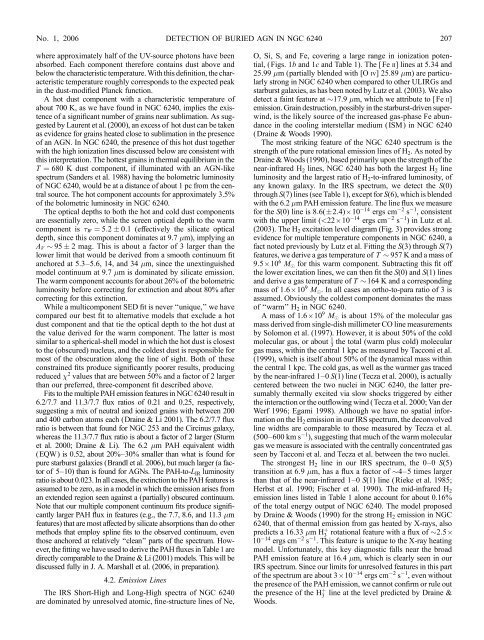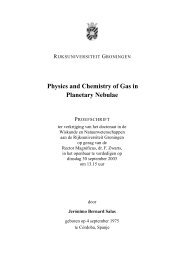ApJ 640, 204 - IRS, The Infrared Spectrograph - Cornell University
ApJ 640, 204 - IRS, The Infrared Spectrograph - Cornell University
ApJ 640, 204 - IRS, The Infrared Spectrograph - Cornell University
You also want an ePaper? Increase the reach of your titles
YUMPU automatically turns print PDFs into web optimized ePapers that Google loves.
No. 1, 2006<br />
DETECTION OF BURIED AGN IN NGC 6240 207<br />
where approximately half of the UV-source photons have been<br />
absorbed. Each component therefore contains dust above and<br />
below the characteristic temperature. With this definition, the characteristic<br />
temperature roughly corresponds to the expected peak<br />
in the dust-modified Planck function.<br />
A hot dust component with a characteristic temperature of<br />
about 700 K, as we have found in NGC 6240, implies the existence<br />
of a significant number of grains near sublimation. As suggested<br />
by Laurent et al. (2000), an excess of hot dust can be taken<br />
as evidence for grains heated close to sublimation in the presence<br />
of an AGN. In NGC 6240, the presence of this hot dust together<br />
with the high ionization lines discussed below are consistent with<br />
this interpretation. <strong>The</strong> hottest grains in thermal equilibrium in the<br />
T ¼ 680 K dust component, if illuminated with an AGN-like<br />
spectrum (Sanders et al. 1988) having the bolometric luminosity<br />
of NGC 6240, would be at a distance of about 1 pc from the central<br />
source. <strong>The</strong> hot component accounts for approximately 3.5%<br />
of the bolometric luminosity in NGC 6240.<br />
<strong>The</strong> optical depths to both the hot and cold dust components<br />
are essentially zero, while the screen optical depth to the warm<br />
component is W ¼ 5:2 0:1 (effectively the silicate optical<br />
depth, since this component dominates at 9.7 m), implying an<br />
A V 95 2 mag. This is about a factor of 3 larger than the<br />
lower limit that would be derived from a smooth continuum fit<br />
anchored at 5.3–5.6, 14, and 34 m, since the unextinguished<br />
model continuum at 9.7 m is dominated by silicate emission.<br />
<strong>The</strong> warm component accounts for about 26% of the bolometric<br />
luminosity before correcting for extinction and about 80% after<br />
correcting for this extinction.<br />
While a multicomponent SED fit is never ‘‘unique,’’ we have<br />
compared our best fit to alternative models that exclude a hot<br />
dust component and that tie the optical depth to the hot dust at<br />
the value derived for the warm component. <strong>The</strong> latter is most<br />
similar to a spherical-shell model in which the hot dust is closest<br />
to the (obscured) nucleus, and the coldest dust is responsible for<br />
most of the obscuration along the line of sight. Both of these<br />
constrained fits produce significantly poorer results, producing<br />
reduced 2 values that are between 50% and a factor of 2 larger<br />
than our preferred, three-component fit described above.<br />
Fits to the multiple PAH emission features in NGC 6240 result in<br />
6.2/7.7 and 11.3/7.7 flux ratios of 0.21 and 0.25, respectively,<br />
suggesting a mix of neutral and ionized grains with between 200<br />
and 400 carbon atoms each (Draine & Li 2001). <strong>The</strong> 6.2/7.7 flux<br />
ratio is between that found for NGC 253 and the Circinus galaxy,<br />
whereas the 11.3/7.7 flux ratio is about a factor of 2 larger (Sturm<br />
et al. 2000; Draine & Li). <strong>The</strong> 6.2 m PAH equivalent width<br />
(EQW) is 0.52, about 20%–30% smaller than what is found for<br />
pure starburst galaxies (Brandl et al. 2006), but much larger (a factor<br />
of 5–10) than is found for AGNs. <strong>The</strong> PAH-to-L IR luminosity<br />
ratio is about 0.023. In all cases, the extinction to the PAH features is<br />
assumed to be zero, as in a model in which the emission arises from<br />
an extended region seen against a (partially) obscured continuum.<br />
Note that our multiple component continuum fits produce significantly<br />
larger PAH flux in features (e.g., the 7.7, 8.6, and 11.3 m<br />
features) that are most affected by silicate absorptions than do other<br />
methods that employ spline fits to the observed continuum, even<br />
those anchored at relatively ‘‘clean’’ parts of the spectrum. However,<br />
the fitting we have used to derive the PAH fluxes in Table 1 are<br />
directly comparable to the Draine & Li (2001) models. This will be<br />
discussed fully in J. A. Marshall et al. (2006, in preparation).<br />
4.2. Emission Lines<br />
<strong>The</strong> <strong>IRS</strong> Short-High and Long-High spectra of NGC 6240<br />
are dominated by unresolved atomic, fine-structure lines of Ne,<br />
O, Si, S, and Fe, covering a large range in ionization potential,<br />
(Figs. 1b and 1c and Table 1). <strong>The</strong> [Fe ii] lines at 5.34 and<br />
25.99 m (partially blended with [O iv] 25.89 m) are particularly<br />
strong in NGC 6240 when compared to other ULIRGs and<br />
starburst galaxies, as has been noted by Lutz et al. (2003). We also<br />
detect a faint feature at 17.9 m, which we attribute to [Fe ii]<br />
emission. Grain destruction, possibly in the starburst-driven superwind,<br />
is the likely source of the increased gas-phase Fe abundance<br />
in the cooling interstellar medium (ISM) in NGC 6240<br />
(Draine & Woods 1990).<br />
<strong>The</strong> most striking feature of the NGC 6240 spectrum is the<br />
strength of the pure rotational emission lines of H 2 . As noted by<br />
Draine & Woods (1990), based primarily upon the strength of the<br />
near-infrared H 2 lines, NGC 6240 has both the largest H 2 line<br />
luminosity and the largest ratio of H 2 -to-infrared luminosity, of<br />
any known galaxy. In the <strong>IRS</strong> spectrum, we detect the S(0)<br />
through S(7) lines (see Table 1), except for S(6), which is blended<br />
with the 6.2 m PAH emission feature. <strong>The</strong> line flux we measure<br />
for the S(0) line is 8:6(2:4) ; 10 14 ergs cm 2 s 1 , consistent<br />
with the upper limit (













